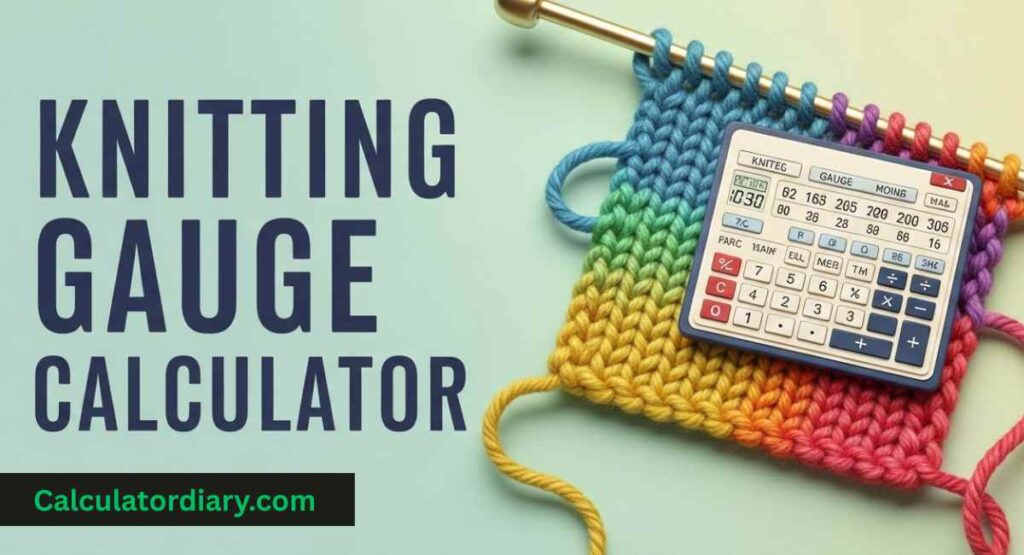Spent hours on a sweater only for it to fit like a potato sack or a too-tight glove? You’re not alone. The culprit is almost always gauge. A knitting gauge calculator is your secret weapon, transforming guesswork into precision. It’s the key to unlocking projects that fit perfectly from the very first cast-on, saving you from frustration and wasted time.
Demystifying Knitting Gauge: Stitch by Stitch, Row by Row
What Exactly is Knitting Gauge?
Simply put, gauge is the number of stitches and rows you knit per inch (or centimeter). It’s your personal knitting fingerprint, revealing how tightly or loosely you knit.
Understanding Stitch Gauge: The Horizontal Measurement
Stitch gauge is the number of stitches across a horizontal measurement. This is critical for determining the circumference of a sleeve or the bust size of a sweater.
Understanding Row Gauge: The Vertical Measurement
Row gauge is the number of rows in a vertical measurement. This controls the length of your project, from a sweater’s body to a hat’s crown.

Laying the Foundation: How to Knit a Perfect Gauge Swatch
The Golden Rule: Always Swatch!
Never, ever skip the swatch. It’s a small time investment that guarantees your final project will be the right size.
Creating Your Gauge Square: The Right Size and Stitch Pattern
Use the yarn and needles your pattern recommends. Cast on enough stitches for a 6-inch square (if the pattern gauge is 4 stitches/inch, cast on 24+ stitches). Always knit in the pattern’s main stitch.
The Transformative Power of Blocking Your Gauge Swatch
Always block your swatch! Yarn relaxes and changes when washed. Measuring an unblocked swatch is like measuring fabric before it’s pre-washed—it’s inaccurate. Wet block your swatch as you plan to wash the finished garment, then let it dry completely.
Precision is Key: Accurately Measuring Your Blocked Gauge
Lay your blocked swatch on a flat surface. Place a rigid ruler over the center (avoid the loose edge stitches!). Count how many stitches fit neatly within 4 inches. Divide by 4 to get your stitches per inch. Repeat for rows.
Introducing Your New Best Friend: The Knitting Gauge Calculator
A gauge calculator does the math for you. Instead of manually calculating how many stitches to cast on for a 40-inch bust, you input your stitch gauge and desired size, and it instantly gives you the magic number.
Step-by-Step: How to Use the Knitting Gauge Calculator
- Input Your Swatch Gauge: Enter your personal stitches and rows per inch.
- Input Your Desired Finished Size: Enter the bust size, length, or width you want.
- Input the Pattern Gauge (if applicable): For pattern adjustments, enter the gauge the designer used.
- Interpret the Results: The calculator tells you exactly how many stitches to cast on and rows to knit to achieve your desired size with your gauge.
Navigating Discrepancies: When Your Gauge Doesn’t Match the Pattern
Your Gauge is Too Tight: What Happens and How to Fix It
Your finished item will be smaller than intended. Fix it: Switch to a larger needle size and re-swatch.
Your Gauge is Too Loose: What Happens and How to Fix It
Your item will be larger and may lack structure. Fix it: Switch to a smaller needle size and re-swatch.
Prioritizing Stitch Gauge vs. Row Gauge
For most garments, stitch gauge is king because it determines width/circumference. Row gauge is easier to adjust by simply knitting more or fewer rows to achieve the desired length.
Beyond Adjustments: Advanced Applications
Use the calculator to substitute yarns! Find a yarn with a similar gauge, or use the calculator to determine what needle size you’ll need with your new yarn to match the pattern’s original gauge, ensuring a perfect fit even with a different fiber.
How do I use a knitting gauge calculator to determine my stitch and row gauge?
Measure your blocked swatch for stitches and rows over 4″ (10 cm), convert to per‑inch/centimeter, then enter those values. The calculator turns them into cast‑on stitches and row counts for your chosen size.
How does changing needle size affect the results from a knitting gauge calculator?
Larger needles usually lower stitches per inch (bigger fabric), smaller needles raise stitches per inch (denser fabric). Update your swatch numbers and the calculator instantly recalculates stitches/rows.
Can a knitting gauge calculator help adjust patterns for different gauge measurements?
Yes. Enter your swatch gauge and the pattern’s target; the tool outputs corrected cast‑ons, lengths, and shaping so your project matches the designer’s dimensions with your yarn and tension.
